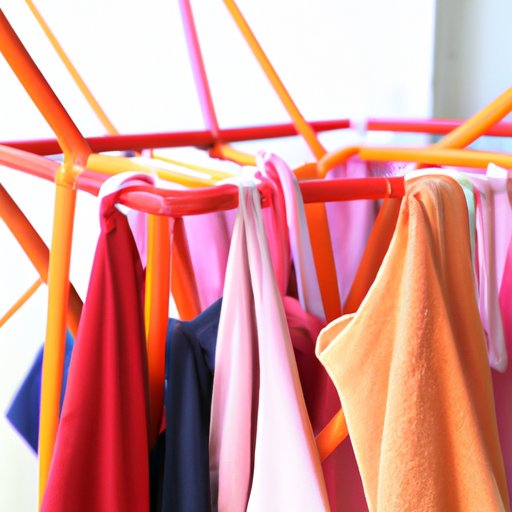
Introduction
Not having a clothes dryer can be a common problem for many individuals. Whether you’re apartment living, traveling or simply don’t own a dryer, it can be frustrating not knowing how to dry your clothes efficiently. Fortunately, there are several alternative methods for drying clothes that do not require a dryer. In this article, we will explore five different techniques for drying clothes without the use of a dryer.
Line Drying
Line drying is one of the most common and traditional methods for drying clothes without a dryer. To line dry clothes, select a suitable location for the line such as an outdoor space or an indoor room with adequate airflow such as a basement. Once a location is selected, position the clothes in the right way to receive maximum airflow. Hang lightweight fabrics closely together to prevent sagging and bunching, and spread heavy fabrics apart on the line to ensure airflow. In selecting a location, the weather should be considered. On a sunny day, clothes can be dried quickly. However, on a cloudy or rainy day, it may take longer. To prevent damage to certain clothes, avoid exposing them to direct sunlight for prolonged periods.
Spin Drying
Using the spin cycle on a washing machine is an efficient way to remove excess moisture from clothes prior to line or air drying. To spin dry clothes, start by grouping the clothes by type and material, then select the correct program cycle and avoid overloading the machine. If the machine is overloaded, the clothes will not spin dry properly and could cause damage to the machine or the clothes. Spin drying clothes will leave them damp, but this is ideal for subsequent air drying.
Towel Drying
Another way to dry clothes without a dryer is to use towels. To towel dry clothes, you’ll need clean towels that are absorbent. Place the article of clothing on the towel, then roll the towel around the article of clothing, pressing gently to absorb excess water. If you use a dirty towel, this can lead to staining or smudging clothes. Roll articles of clothing tightly to avoid wrinkles.
Air Drying
When air drying clothes, circulation is key. To begin air drying clothes, lay them flat on a surface or hang them up using clips or hangers. When hanging clothes, choose a well-ventilated area and place a fan nearby or open windows to ensure good air circulation. Air drying can take longer than other methods, but it can be a preferable option for delicate or sensitive garments that could shrink or stretch if hung on a line.
Iron Drying
Use an iron to dry clothes is another effective solution. To do this, first, lay the damp clothing on an ironing board. Next, set the iron to the appropriate heat level and use a clean, dry pressing cloth to protect the clothing as you iron. Gently move the iron across the garment, gradually drying it over time. This method is best when only small areas of the garment require drying and is not an ideal overall drying method.
Conclusion
While not having a dryer can be problematic, there are several methods for drying clothes without one that are just as effective. From line drying and spin drying to towel, air and iron drying, it’s important to discover what works best for you and your clothes. By using our tips and suggestions, you can find the right method that fits your situation, ultimately saving you money and giving your clothes the care they deserve.




